Finding yourself stuck on the side of the road waiting for a tow truck can be a nerve-wracking experience, especially in a bustling city like Buffalo. Whether it’s a flat tire or an unexpected breakdown, knowing how to stay safe while waiting for help is essential. Being prepared and aware of the steps to take can make a significant difference in your experience.
Assessing the Situation
When your car breaks down, the first step is to take a moment and assess your situation. Look around to identify potential safety hazards. If you’re on a busy street or highway, make sure you’re not in the direct path of oncoming traffic. Ensure there’s enough space between your car and other vehicles passing by. Watch out for any nearby obstacles, like guardrails or debris that could put you at risk.
Keeping calm and composed is crucial. Panicking can cloud your judgment and lead to missteps. Take a deep breath and focus on addressing the situation methodically. Remember, staying calm enables you to think more clearly and react appropriately.
Deciding whether to stay in the vehicle or move to a safer location is an important consideration. Here are some tips to guide your decision:
- Consider Traffic Flow: If traffic is heavy and the road conditions are poor, it’s usually safer to stay inside the vehicle with the seatbelt fastened.
- Evaluate the Weather: In extreme weather conditions like heavy rain or snow, staying inside the car is often the best choice.
- Physical Surroundings: If you’re parked safely off the road, exiting the vehicle might be a viable option. Move away from the road and use barriers as protection.
By evaluating the situation calmly and rationally, you can make informed choices that prioritize your safety.
Making Your Vehicle Visible
Enhancing your vehicle’s visibility is essential to keeping you and your car safe from other drivers. Start by turning on your hazard lights immediately after pulling over. This signal alerts other drivers that your vehicle is stopped, and they need to proceed with caution.
Using reflective gear can further improve visibility, especially in dim conditions. If available, place warning triangles or flares around your vehicle. Position these items in a visible pattern to alert oncoming traffic from a safe distance. Always be cautious when placing these items, ensuring you don’t put yourself in harm’s way.
Here are some effective ways to make your vehicle more visible:
- Hazard Lights and Reflective Gear: Immediately activate your hazard lights and wear reflective vests if available.
- Warning Triangles: Set up warning triangles at intervals behind your vehicle to provide advanced warning to other drivers.
- Flare Usage: If it’s safe, ignite flares and place them strategically. Flares can be especially helpful in nighttime or poor weather conditions.
Ensure your vehicle is as far off the road as possible. Avoid creating a blockage for traffic, keeping your car close to the curb or shoulder. This minimizes the risk of another vehicle colliding with yours, increasing safety for you and other road users.
Staying Safe While Waiting
If staying inside your vehicle is the safest option, there are several things you can do to protect yourself. First, keep your seatbelt fastened in case another vehicle accidentally hits yours. Lock your doors and keep the windows rolled up to ensure additional security. Using the rearview and side mirrors can help you remain aware of your surroundings without leaving the safety of your car.
If it’s safe to be outside, choose your position wisely. Stand well away from traffic, and use guardrails or other barriers to protect yourself from oncoming vehicles. Make sure you’re visible to other drivers, wearing bright or reflective clothing if possible. Avoid walking on the road, and stay aware of traffic at all times.
Protecting your personal belongings should also be a priority. If you need to step away from the car, take any valuable items with you, or keep them securely hidden inside the vehicle. This reduces the chance of theft and ensures your belongings stay safe while help is on the way.
Communicating with Help
Clear communication with the towing service is vital to ensure a quick and effective response. Start by providing accurate details of your location. If possible, use landmarks, road signs, or GPS coordinates to help describe exactly where you are. This helps the towing service navigate to your location promptly.
Having key information ready will speed up the process. When calling for a tow, be prepared to share your car’s make, model, and color. Explain the nature of your problem, such as a flat tire or engine issue. This helps the towing company prepare the right equipment for your needs.
Staying in contact with the towing company is equally important. Keep your phone handy and check for any update calls or messages from them. They might inform you of the estimated time of arrival or offer further instructions about staying safe until they arrive. Open communication ensures a smooth and efficient towing experience.
Conclusion
Being stranded on the side of the road can be a daunting experience, but knowing how to stay safe while waiting for a tow truck makes all the difference. Whether evaluating your surroundings for safety, making sure your vehicle is visible, or communicating effectively with help, every step you take contributes to a more secure situation. Remember, staying calm and well-prepared allows you to handle roadside emergencies with confidence.
When finding yourself in need of assistance, contacting Schoemann’s Road Service, Inc. ensures you receive prompt and professional help. Our team is dedicated to providing reliable local towing and roadside services to get you back on the road safely. Trust us to be there when you need it most, offering peace of mind and a swift response to any road troubles you encounter!


